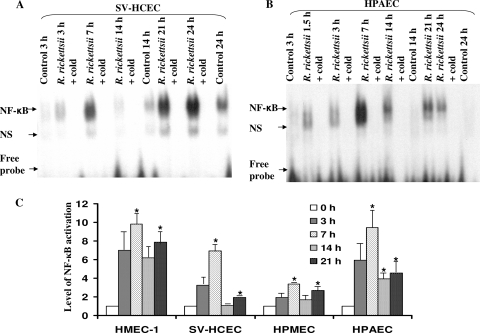FIG. 1.
Effect of R. rickettsii infection on NF-κB activation in micro- and macrovascular human endothelial cells. ECs were either infected with R. rickettsii or incubated with the antibiotic-free culture medium alone (Control). Gel-shift analysis was carried out to measure the DNA-binding activity using nuclear extracts (2 μg protein) and a consensus NF-κB sequence. Specificity of DNA-protein binding was ascertained by inclusion of approximately 50-fold molar excess of unlabeled probe in the assay (+cold). The autoradiographic exposures from a typical experiment with human microvascular cerebral ECs (SV-HCECs [A]) and pulmonary artery ECs (HPAECs [B]) are shown. The arrows indicate relative positions of the NF-κB complex, a nonspecific band (NS), and unbound radioactivity in the reaction mixture (Free probe) on the gel. Panel C represents quantitative densitometric analysis of NF-κB activation in organ-specific ECs after R. rickettsii infection in relation to the uninfected controls (0 h), which were assigned a value of 1. The data are presented as the mean ± standard error of the mean (SEM) from a minimum of three independent experiments (n ≥ 3). The asterisks indicate statistically significant differences (P ≤ 0.05) in comparison to the corresponding uninfected controls.

